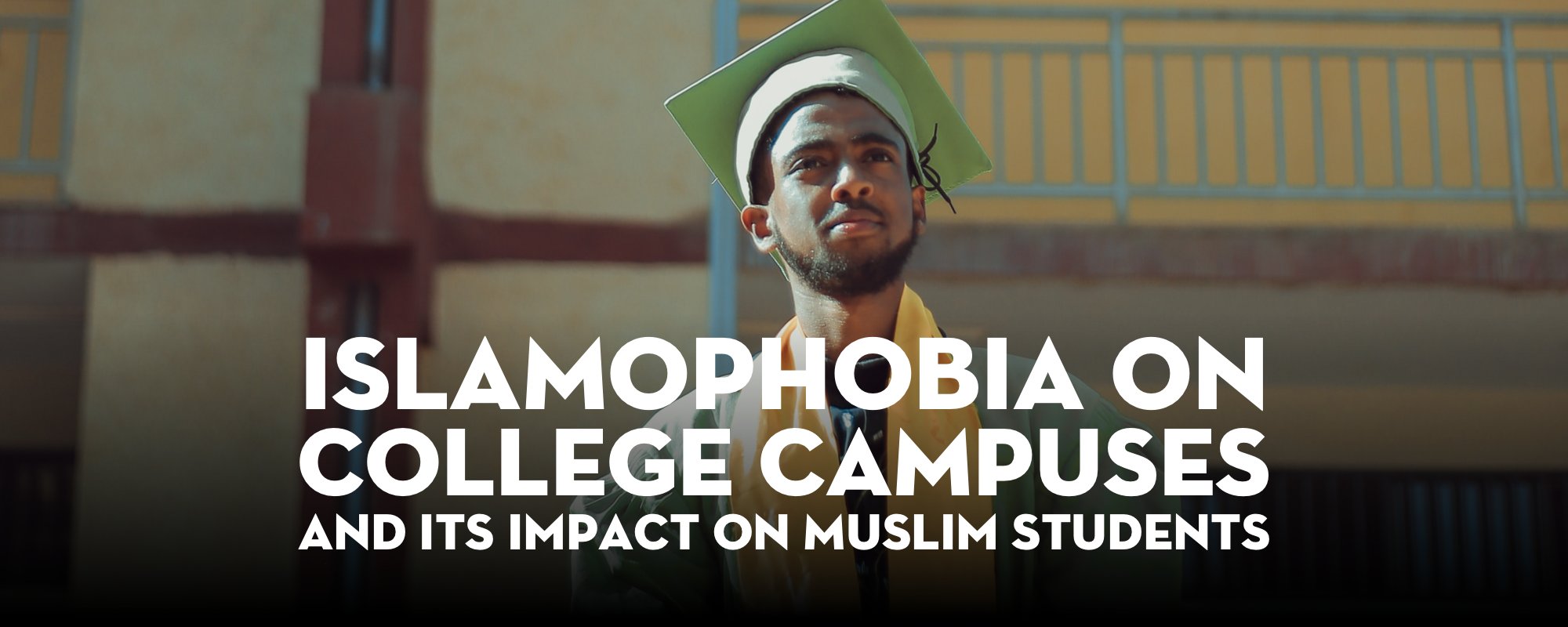
In this report, the California Chapter of the Council on American-Islamic Relations (CAIR-CA) presents its analysis of a 2019-2020 college campus climate survey of American Muslim college and university students.
The survey was administered to students at over sixty institutions of higher learning primarily throughout the state of California, including both public and private universities and colleges. Its purpose is to examine the lived experiences of American Muslim college students and the issues they face, particularly as a consequence of their real or perceived Muslim identities.
Muslim students today are a vibrant and
burgeoning segment of the general population. In
the United States, Muslim young adults make up
a significant portion of the American Muslim population.
It is estimated that roughly 35% of all American Muslim
adults fall between the ages of 18 and 29, compared to
only 21% of the overall adult U.S. population that falls
within the same age bracket.1 Consequently, Muslims in
the United States today are younger than the average
American population. They are also just as likely to
graduate college as the general population, with 31%
of U.S. Muslims obtaining higher education degrees.2
However, the survey findings highlight significant issues
facing the American Muslim student body, such as
Islamophobia and discrimination based on the students’
real or perceived Muslim identities or related campus
advocacy.
Key findings demonstrated that a notable percentage of
Muslim students experienced some form of harassment
or discrimination by peers, campus administration, and/or campus personnel. Muslim students also reported
high levels of discomfort in various campus settings and
limitations to their ability to express themselves on issues
related to their religious identity. The survey highlighted
concerns regarding campus administrators’ support for
events or policies hostile to Islam, as well as campus
omissions and failures to take measures to protect or
accommodate Muslim students.
558 STUDENTS FROM OVER 60 INSTITUTIONS OF HIGHER LEARNING RESPONDED TO CAIR-CA’S SURVEY
TWEET THIS
CAIR-CA has repeatedly advocated on behalf of American
Muslim students, who faced escalating incidents of anti-
Muslim bias in the period following September 11, 2001.
This bias has only intensified with the current government
administration. In the year leading up to the 2016 elections, the FBI reported a 67% increase in anti-Muslim
hate crimes, while CAIR-CA recorded a staggering 584%
surge in anti-Muslim hate crimes3 from 2014 to 20164 In the
five days following the 2016 presidential election, more
than 30 cases of anti-Muslim incidents and over 120 anti-immigrant
incidents were reported across the nation.5 Of
these, over 60 incidents took place at universities.6 In
2017, CAIR offices nationwide reported a 15% increase
in hate crimes, hate incidents, and discrimination against
Muslims in the United States.7
In response to the increasing Islamophobia, CAIR-CA
has provided direct legal services to students who
have been subjected to religious-based discrimination
and harassment. CAIR-CA has also worked to educate
college students regarding their rights. Specifically, we
have provided workshops across California educating
college students regarding their rights to freedom of
religion, religious accommodations, freedom of speech,
the right to protest, and their right to be free from unlawful
or harmful censorship and surveillance on campus.
CAIR-CA has also developed ongoing legislative and
policy initiatives encouraging schools to enforce antidiscrimination
measures and protect all students’ right to
free speech and religious expression.

These survey findings show that while Muslim students have become more visible on campuses, they are still often subjected to pervasive stereotypes, micro-aggressions, harassment, and discrimination due to their religious identity or political advocacy. In this report, CAIR-CA offers recommendations to students and schools to ensure that college campuses remain a haven for individual expression and growth, free of discrimination and harassment.
56.46% Female 43.01% Male 0.53% Declined
RESPONDENT’S GENDER
TWEET THIS
The survey was administered from January 2019 through March 2020 by CAIR-CA’s four offices covering the Greater Los Angeles Area, Sacramento Valley and Central California, San Diego, and San Francisco Bay Area. Survey results were obtained in person and through a secure online portal.8 568 responses were received, with a 92% completion rate. 43.01% of respondents identified as male, 56.46% identified as female, and 0.53% declined to identify their gender.
Respondent's Self-Identified Ethnicity
TWEET THIS
Of the students who provided their ethnicity, the largest subgroup identified with an ethnic group from Asia or South Asia,9 followed by respondents who identified as Arab, Middle Eastern, or North African.10 A minority of respondents making up less than 1% of the survey sample identified as African American, Ethiopian, Somalian, Black, Mexican, Latino, Hispanic, White, Pacific Islander, or Mixed. Nearly three-quarters of students in this sample were pursuing their undergraduate degrees, while less than 1% were pursuing their Associates, Masters, or Doctor of Philosophy degrees. Over 85% of all respondents expected to graduate between 2020 and 2025, and 12% graduated in 2019.
[1] 49.77% Hijab [2] 32.42% Beard [3] 5.71% Thobe [4] 5.02% Abaya [5] 6.62% Other
strong trend toward religious or cultural visibility on campus
TWEET THIS
The survey sample demonstrated a strong trend toward
religious or cultural visibility on campus, whether through
religious attire, appearance, or identity-based group
affiliations. For example, an overwhelming 92.24% of
students reported wearing some form of religious or
cultural attire. 49.77% wore a hijab11 or other similar
religious head covering, 32.42% donned a beard, 5.71% wore a
thobe, 5.02% wore an abaya, and 3.65% wore a
kufi. Another 6.62% indicated they wore another type
of attire such as a rosary, headcap, Islamic jewelry,
modest clothing,
niqab, clothing with Arabic calligraphy,
and some indicated they looked Muslim.
Additionally, 65.12% of students surveyed also
participated in some form of Muslim Student Association
or Union. An additional 0.09% of student respondents
were part of ethnic or national origin groups that may
be perceived as Muslim-presenting, such as Palestinian
advocacy groups, the Persian Student Association, or
the Pakistani Student Association.